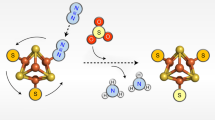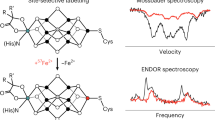Abstract
Molybdenum nitrogenase catalyses the reduction of N2 to NH3 at its cofactor, an [(R-homocitrate)MoFe7S9C] cluster synthesized via the formation of a [Fe8S9C] L-cluster prior to the insertion of molybdenum and homocitrate. We have previously identified a [Fe8S8C] L*-cluster, which is homologous to the core structure of the L-cluster but lacks the ‘ninth sulfur’ in the belt region. However, direct evidence and mechanistic details of the L*- to L-cluster conversion upon ‘ninth sulfur’ insertion remain elusive. Here we trace the ‘ninth sulfur’ insertion using SeO32− and TeO32− as ‘labelled’ SO32−. Biochemical, electron paramagnetic resonance and X-ray absorption spectroscopy/extended X-ray absorption fine structure studies suggest a role of the ‘ninth sulfur’ in cluster transfer during cofactor biosynthesis while revealing the incorporation of Se2−- and Te2−-like species into the L-cluster. Density functional theory calculations further point to a plausible mechanism involving in situ reduction of SO32− to S2−, thereby suggesting the utility of this reaction to label the catalytically important belt region for mechanistic investigations of nitrogenase.

This is a preview of subscription content, access via your institution
Access options
Access Nature and 54 other Nature Portfolio journals
Get Nature+, our best-value online-access subscription
$29.99 / 30 days
cancel any time
Subscribe to this journal
Receive 12 print issues and online access
$259.00 per year
only $21.58 per issue
Buy this article
- Purchase on Springer Link
- Instant access to full article PDF
Prices may be subject to local taxes which are calculated during checkout






Similar content being viewed by others
Data availability
The authors declare that all data supporting the findings of this study are available within the article, the Supplementary Information and the source files published alongside the article. Source data are provided with this paper.
References
Burgess, B. K. & Lowe, D. J. Mechanism of molybdenum nitrogenase. Chem. Rev. 96, 2983–3012 (1996).
Buscagan, T. M. & Rees, D. C. Rethinking the nitrogenase mechanism: activating the active site. Joule 3, 2662–2678 (2019).
Rutledge, H. L. & Tezcan, F. A. Electron transfer in nitrogenase. Chem. Rev. 120, 5158–5193 (2020).
Jasniewski, A. J., Lee, C. C., Ribbe, M. W. & Hu, Y. Reactivity, mechanism, and assembly of the alternative nitrogenases. Chem. Rev. 120, 5107–5157 (2020).
Spatzal, T. et al. Evidence for interstitial carbon in nitrogenase FeMo cofactor. Science 334, 940 (2011).
Wiig, J. A., Hu, Y., Lee, C. C. & Ribbe, M. W. Radical SAM-dependent carbon insertion into the nitrogenase M-cluster. Science 337, 1672–1675 (2012).
Lee, S. C., Lo, W. & Holm, R. H. Developments in the biomimetic chemistry of cubane-type and higher nuclearity iron–sulfur clusters. Chem. Rev. 114, 3579–3600 (2014).
Ohki, Y. & Tatsumi, K. New synthetic routes to metal–sulfur clusters relevant to the nitrogenase metallo-clusters. Z. Anorg. Allg. Chem. 639, 1340–1349 (2013).
Ribbe, M. W., Hu, Y., Hodgson, K. O. & Hedman, B. Biosynthesis of nitrogenase metalloclusters. Chem. Rev. 114, 4063–4080 (2014).
Hu, Y. & Ribbe, M. W. Biosynthesis of the metalloclusters of nitrogenases. Annu. Rev. Biochem. 85, 455–483 (2016).
Tanifuji, K. et al. Tracing the ‘ninth sulfur’ of the nitrogenase cofactor via a semi-synthetic approach. Nat. Chem. 10, 568–572 (2018).
Jasniewski, A. J. et al. Spectroscopic characterization of an eight-iron nitrogenase cofactor precursor that lacks the “9th sulfur”. Angew. Chem. Int. Ed. 58, 14703–14707 (2019).
Hu, Y. et al. FeMo cofactor maturation on NifEN. Proc. Natl Acad. Sci. USA 103, 17119–17124 (2006).
Hu, Y. et al. Nitrogenase Fe protein: a molybdate/homocitrate insertase. Proc. Natl Acad. Sci. USA 103, 17125–17130 (2006).
Hu, Y. & Ribbe, M. W. Maturation of nitrogenase cofactor—the role of a class E radical SAM methyltransferase NifB. Curr. Opin. Chem. Biol. 31, 188–194 (2016).
Kang, W. et al. Crystallographic analysis of NifB with a full complement of clusters: structural insights into the radical SAM-dependent carbide insertion during nitrogenase cofactor assembly. Angew. Chem. Int. Ed. 60, 2364–2370 (2020).
Rettberg, L. A. et al. Identity and function of an essential nitrogen ligand of the nitrogenase cofactor biosynthesis protein NifB. Nat. Commun. 11, 1757 (2020).
Rettberg, L. A. et al. Probing the coordination and function of Fe4S4 modules in nitrogenase assembly protein NifB. Nat. Commun. 9, 2824 (2018).
Musgrave, K. B., Angove, H. C., Burgess, B. K., Hedman, B. & Hodgson, K. O. All-ferrous titanium(iii) citrate reduced Fe protein of nitrogenase: an XAS study of electronic and metrical structure. J. Am. Chem. Soc. 120, 5325–5326 (1998).
Einsle, O. et al. Nitrogenase MoFe-protein at 1.16 Å resolution: a central ligand in the FeMo-cofactor. Science 297, 1696–1700 (2002).
Ciurli, S., Yu, S. B., Holm, R. H., Srivastava, K. K. P. & Munck, E. Synthetic nickel–iron NiFe3Q4 cubane-type clusters (S = 3/2) by reductive rearrangement of linear [Fe3Q4(SEt)4]3− (Q = sulfur, selenium). J. Am. Chem. Soc. 112, 8169–8171 (1990).
Bobrik, M. A. et al. Selenium substitution in [Fe4S4(SR)4]2−: synthesis and comparative properties of [Fe4X4(YC6H5)4]2− (X, Y = sulfur, selenium) and the structure of [(CH3)4N]2[Fe4Se4(SC6H5)4]. Inorg. Chem. 17, 1402–1410 (1978).
Barbaro, P., Bencini, A., Bertini, I., Briganti, F. & Midollini, S. The tetranuclear trianion [Fe4Te4(SC6H5)4]3−: crystal and molecular structure and magnetic properties. J. Am. Chem. Soc. 112, 7238–7246 (1990).
Simon, W., Wilk, A., Krebs, B. & Henkel, G. [Fe4Te4(TePh)4]3−, the first telluride–tellurolate complex. Angew. Chem. Int. Ed. 26, 1009–1010 (1987).
Zimmermann, M. D. & Tossell, J. A. Acidities of arsenic(iii) and arsenic(v) thio- and oxyacids in aqueous solution using the CBS-QB3/CPCM method. J. Phys. Chem. A 113, 5105–5111 (2009).
Kang, W., Lee, C. C., Jasniewski, A. J., Ribbe, M. W. & Hu, Y. Structural evidence for a dynamic metallocofactor during N2 reduction by Mo-nitrogenase. Science 368, 1381–1385 (2020).
Spatzal, T., Perez, K. A., Howard, J. B. & Rees, D. C. Catalysis-dependent selenium incorporation and migration in the nitrogenase active site iron–molybdenum cofactor. Elife 4, e11620 (2015).
Spatzal, T., Perez, K. A., Einsle, O., Howard, J. B. & Rees, D. C. Ligand binding to the FeMo-cofactor: structures of CO-bound and reactivated nitrogenase. Science 345, 1620–1623 (2014).
Acknowledgements
This work was supported by NIH-NIGMS grants GM67626 (to M.W.R. and Y.H.), GM141046 (to Y.H. and M.W.R.), R35 GM126961 (to R.D.B.), GM110501 (to J.Y.) and GM126289 (to J.K.). Y.O. was supported by Grant-in-Aids for Scientific Research (MEXT Japan) (nos. 19H02733 and 20K21207), International Collaborative Research Program of ICR, Kyoto University, Takeda Science Foundation and Tatematsu Foundation. K.T. recieved support from the Kyoto University Research Fund for Young Scientist (Start-Up). XAS data were collected at Beamlines 7-3 and 9-3 at the Stanford Synchrotron Radiation Lightsource, SLAC National Accelerator Laboratory. SLAC is supported by the US Department of Energy, Office of Science, Office of Basic Energy Sciences under contract no. DE-AC02-76SF00515. The SSRL Structural Molecular Biology Program is supported by the DOE Office of Biological and Environmental Research, and by the National Institutes of Health, National Institute of General Medical Sciences (including P30GM133894).
Author information
Authors and Affiliations
Contributions
K.T., A.J.J., M.T.S., C.C.L, Y.H. and M.W.R. designed experiments. K.T., A.J.J., M.T.S., C.C.L, D.V., J.W., R.C., I.B., J.Y., J.K., R.D.B., Y.H. and M.W.R. analysed data. K.T., A.J.J., M.T.S., C.C.L., D.V., J.W., R.C., I.B., J.Y and J.K. performed experiments. Y.O., B.H. and K.O.H provided material and/or technical resources. Y.H. and M.W.R. wrote the manuscript with input from all authors.
Corresponding authors
Ethics declarations
Competing interests
The authors declare no competing interests.
Additional information
Peer review information Nature Chemistry thanks Benoit D’Autréaux and the other, anonymous, reviewer(s) for their contribution to the peer review of this work.
Publisher’s note Springer Nature remains neutral with regard to jurisdictional claims in published maps and institutional affiliations.
Supplementary information
Supplementary Information
Supplementary methods, Figs. 1–3, Tables 1–7 and references.
Source data
Source Data Fig. 1
Source Data Fig. 1a–c
Source Data Fig. 2
Source Data Fig. 2a,b.
Source Data Fig. 3
Source Data Fig. 3a–c.
Source Data Fig. 4
Source Data Fig. 4a–c.
Source Data Fig. 5
Source Data Fig. 5c
Source Data Fig. 6
Source Data Fig. 6a,b.
Rights and permissions
About this article
Cite this article
Tanifuji, K., Jasniewski, A.J., Villarreal, D. et al. Tracing the incorporation of the “ninth sulfur” into the nitrogenase cofactor precursor with selenite and tellurite. Nat. Chem. 13, 1228–1234 (2021). https://doi.org/10.1038/s41557-021-00799-8
Received:
Accepted:
Published:
Issue Date:
DOI: https://doi.org/10.1038/s41557-021-00799-8



